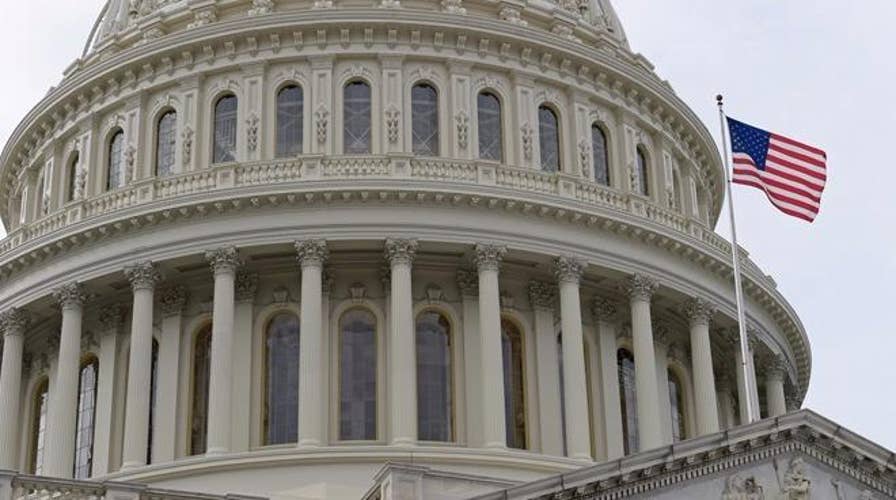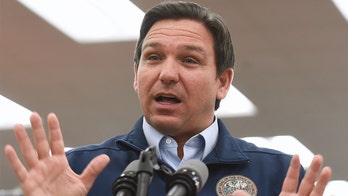Conservatives storm Capitol Hill over ObamaCare repeal
Strategy Room: Jeanne Zaino and Flip Pidot on how activists are putting pressure on Congress
The debate on Capitol Hill now focuses on health care.
But it’s really about 2018.
Major, electoral tidal waves sometimes crash into the members of the president’s party in their first midterm election.
Think 1966 after President Lyndon Johnson’s first election in 1964.
LBJ advanced many of his Great Society programs in Congress. But voters revolted over the Voting Rights Act, big spending, Vietnam and racial unrest. Republicans picked up a staggering 47 House seats. But the Democrats’ distended House majority shrank only from 295 seats to 248 seats. Democrats maintained the majority.
Then there was 1994.
Republicans flipped control of the House for the first time in 40 years, pocketing an eye-popping 54 seats. Analysts viewed the GOP’s triumphs as a repudiation to President Bill Clinton’s failed efforts at health care reform and gun control provisions in a major crime bill.
And of course, consider 2010.
With President Obama in in the White House and big majorities in the House and Senate, Democrats approved a massive stimulus package, ObamaCare and the financial reform measure now known as Dodd-Frank. Climate legislation called “cap and trade” eked its way through the House of Representatives but died in the Senate.
Republicans reclaimed the House in the 2010 midterm elections, winning an astonishing 63 seats.
Congressional Republicans are mindful of this midterm phenomenon which waylays members of a first-term president in the initial midterm. GOP strategists fret about what could happen if they fail to deliver on promises to repeal and replace ObamaCare, construct a border wall and approve tax reform.
But consider the converse …
What happens if Republicans are successful in their efforts to repeal and replace ObamaCare?
Republicans now occupy 237 House seats, down from their high-water mark of 241 before several resignations. Political parties don’t capture these big majorities in Congress to sit on them. They win these seats to execute major legislative initiatives … and burn seats in the process.
Vice President Pence descended on Capitol Hill twice Wednesday to huddle with House Republicans. He met midday with the Republican Study Committee (RSC), the largest bloc of conservatives in the House. Pence returned in the late afternoon for confabs with the “Tuesday Group,” a coalition of 50-plus moderate Republicans. The vice president then talked to the entire House Republican Conference.
“This president and this administration are standing shoulder-to-shoulder with you,” said Pence to the GOP Conference, according to a source in the room. “We’re going to support this bill.”
And what about those who don’t?
The House Republican whip operation sprang into action Wednesday night, checking in with rank-and-file members. Are they yea? A nay? Lean yes? Lean no? Undecided?
The GOP can only lose 22 votes before the bill is toast.
“This bill is a win for conservatives,” boasted House Budget Committee Chairwoman Diane Black, R-Tenn.
There’s a plan to mollify conservatives by offering a slate of at least four non-binding motions to gin up conservative votes for the health care bill. Those motions include more state flexibility for Medicaid, work requirements for childless, able-bodied persons in order to receive Medicaid, ending the Medicaid expansion at the end of this year and some changes in tax credits to true deductions.
Consider the challenges some lawmakers face to support the bill. Look at Reps. Martha McSally, R-Ariz.; Hal Rogers, R-Ky.; and David Valadao, R-Calif. McSally represents one of the most-prominent battleground districts in the country. Hillary Clinton won McSally’s district with 49 percent of the vote. President Trump scored 44 percent. Moderates like McSally met with Pence. That group argued they are the “majority makers.” In other words, Republicans wouldn’t control the House without them. So, moderates ask why conservatives who win their districts by large margins aren’t the ones taking a hit. Meantime, if Republicans “screw up” the health care bill, Republicans could risk losing those seats – and the majority – if moderate GOPers vote yea.
Valadao represents one of the poorest districts in the nation. Nearly half of his constituents are on Medicaid. Medicaid cuts could be devastating. Then there is Rogers. He represents a rural, “older” district where Medicaid is popular. Never mind how many people in Rogers’s district gained insurance for the first time under ObamaCare. A “wrong” vote by these lawmakers could spell disaster at the polls.
Black may tout what the bill does for conservatives. But the trick to passing the bill could center on how GOP leaders lure moderates.
Rep. Tom MacArthur, R-N.J., represents a district with the highest percentage of seniors in New Jersey. He said moderates told Pence during their meeting that altering the Medicaid expansion date is “a non-starter for us.”
MacArthur took a pass when pressed if conservatives were scoring wins in the bill and moderates would have to pick up the slack and vote yes.
“I’m not going to react to that,” said MacArthur. “This is not about the politics between moderates and conservatives.”
But MacArthur conceded that conservative and moderate Republicans come from “different tribes” within the same family. He added that “a lot of the work gets done here on the backs of centrist Republicans.”
Many Republicans like MacArthur represent districts that could trend Democratic under the right circumstances. History shows that historic midterm elections sometimes unfold just two years after a new President assumes office.
The Republican brain trust may want to repeal and replace ObamaCare. They don’t have the votes to do so yet.
Political parties don’t score these big majorities just to sit on them. Want to repeal and replace ObamaCare? Republicans may have to burn the seats of vulnerable members from battleground districts to get there. And that wouldn’t be the first time members paid for a president’s major legislative initiatives in a midterm election.
Capitol Attitude is a weekly column written by members of the Fox News Capitol Hill team. Their articles take you inside the halls of Congress, and cover the spectrum of policy issues being introduced, debated and voted on there.





